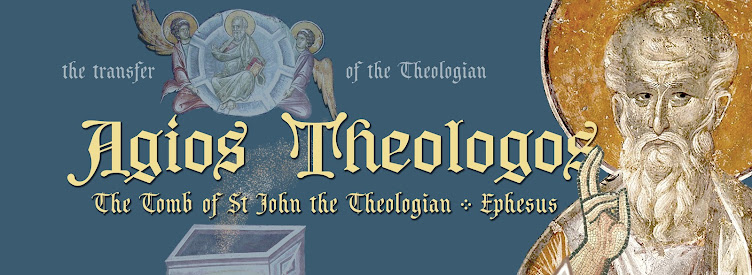The greatest Byzantine emperor-builder St
Justinian I (who some believe to be a Slav by birth, named Upravda) in the 6th
century built on this same place a significantly larger church, 130 x 65
meters, which in it its beauty and richness of interior and exterior was only
comparable to the other Emperor Justinian’s jewels of Constantinople, Hagia
Sophia and the Holy Apostles.
Five large and five smaller cupolas
crowned the grandiose structure. It appears that the sepulcher basilica of St
John the Theologian was the first in the world to boast so many domes. The
interior windows, walls, pillars, arches and cupolas were adorned mainly with
mosaics, along with some frescoes. It had marble slabs of various colors,
patterns and structures which can still be seen today in their full splendor in
Hagia Sophia in Constantinople. Brilliant mosaics were inlaid into the marble
floors. Soaring above were capitals, beams, and arches of exquisitely carved
Parian marble. Gold- and silver-gilt
marble paneling decorated some parts of the church, especially the altar.
Between the treasury and the north wall of
the transept of the basilica are the remains of a small chapel, to be exact,
its apse, with partially preserved frescoes from before the 9th
century, which show Our Lord Jesus Christ, and to His right and left sides, the
Holy Apostle John the Theologian and the Holy Apostle Timothy, bishop of
Ephesus.
On the north side of the basilica is a large octagonal baptistry canopied by a sixth cupola.
 |
| Contemporary picture of the ruins of the Sepulcher Basilica of St John the Theologian. St John the Theologian’s grave is marked by the red square, the Hermitage of the Theologian by the red pin. |
Right next to the basilica was the
episcopal palace and various other buildings, along with a large underground
cistern for water with marble supporting columns like in Constantinople (an
underground palace).
The basilica of the tomb of St. John the
Theologian was one of the largest and most splendid churches in the entire
world at the time. Considering the fact that the basilica takes up the entire
width of the hill, it is safe to assume that the topography of its location had
been larger, it would have been larger as well. It was one of the wonders of
the medieval world.
Since where the basilica was built was
completely without water, Emperor Justinian ordered the building of a
magnificent above-ground aqueduct, raised on stone arches, the remains of which
still grace downtown Selçuk.
The aqueduct brought fresh, potable water from the nearby village of Şırınce to provide for the needs
of the basilica and its surrounding neighborhood. It was much thanks to
Justinian’s aqueduct that the village of Agios Theologos was able to expand and
grow throughout the centuries. In and of itself, the aqueduct is a marvel of
architecture, consisting of 124 arches, 7 meters above ground, and 656 meters
long.
Above the basilica of St John, the Agios
Theologos hill is crowned by a citadel, which combined with the fortifications
of the basilica, forms one giant oval of high walls and towers, built by the
Byzantines in the fifth century to protect the basilica from Arab conquest.
According to ancient church tradition, St. John used to come to this hill to pray and it was there that he wrote his Gospel. In memory of this tradition, the Byzantines built another, much smaller basilica on the top of the hill where it is believed that St. John wrote the Gospel. After Turks conquered the area, they partially demolished this church and made the remaining part, the altar, a cistern for collecting rainwater.
 |
|
Looking upon the hill and fortress of the
Holy Theologian from the sea, or from any other sides of the Ephesus valley,
one immediately notices that it is the one high point which dominates the area,
almost mythical in appearance, which leaves no one indifferent. We can only imagine what an amazing sight it
was once upon a time: the huge five-cupola basilica of St John the Theologian,
one of the wonders of the medieval world, a masterpiece of Christian
architecture.
-Excerpt from the book Agios Theologos:
the Tomb of St. John the Theologian and Other Holy Sites of Ephesus, a
Pilgrim’s Guide, by Bishop Akakije of Uteshiteljevo (in the process of
publication)


No comments:
Post a Comment